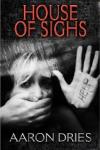House of Sighs
Aaron Dries
Samhain Publishing
Paperback, Digital, Audio Editions
Review by La Diva
Horror literature (and cinema) is often defined by context and subtext, and both seriously come into play here. House of Sighs, like the best fiction, works on a number of levels. If you want a hard-core thrill ride, you’ll get it. If you demand more, it’s very much there. It’s this balance that makes horror scary.
The novel opens in rural Australia in the mid-nineties and what follows is a fast-paced narrative that just … does … not … stop. It’s relentless without being exhausting — a challenging mix, indeed. We meet our anti-heroine, Liz Frost, a woman on the edge of suicide, who instead of using her father’s gun on herself, puts it in her bag and takes it to work. She is a bus driver. One by one her passengers are established — there’s the pregnant teen, her American half-sister, a wannabe writer, the chauvinist, the man who lives in fear of his wife, the aging woman who is losing her faith and the young gay man on the cusp of adulthood. When all of these people come together chaos ensues, driving them all towards one inevitable location: the House of Sighs, a lonely building in an open valley. A lot of bad stuff has happened within those walls over the years — of this Liz Frost knows better than anyone. And she is taking her passengers there. Home to meet her family.
Told in a well-written, literate style, House of Sighs digs deep into a lot of the social prejudices and concerns of the mid-nineties, and intentionally draws sad parallels with today. Tackling issues such as gun control, homophobia, racism and spousal abuse, the book takes no punches and shows little mercy. Yet despite so much horror, there are often passages of incredible, honest beauty — one character’s Thailand flashback for example. That’s not to say there isn’t a great deal of disturbing violence, but thankfully it’s all justified, and while explicit, it’s never exploitative. One is reminded of reading Jack Ketchum’s Off Season for the first time; only Dries’ novel has an inherent sensitivity to it that Ketchum’s debut lacked (he certainly found his stride later on).
The characters are very well drawn (a make-or-break factor when dealing with ensemble casts); the psychological reasoning for their motivations is explored in depth, and is frighteningly real… There is a definite ‘nurture vs. nature’ theme running throughout and smartly, Dries does not cast judgment — but the question is certainly raised. The pace is fast; all details vividly realised; and it’s alive with suspense (the chapter numbers are listed backwards in a dread-infused count-down to disaster). The setting is vivid and some daring plot-twists and challenging character motivations are dealt with an expert hand. Dries throws in a fair share of red herrings and MacGuffins in a number of clever ways — and it’s all very cinematic. You can see the heat waves rising off the road, feel every shard of glass and hear the desperate cries. Australian readers will revel in the local detail (with references to real-world fires, police events and even the 1995 Grand Prix!) but the themes (and Dries’ concerns) are universal and the primal terror will translate to any audience
This is a deeply unsettling book and a powerful debut. There isn’t enough quality Australian horror fiction out there, and in the face of this, Dries proves himself an author to watch. House of Sighs serves psychological horror straight up and without sensation, or apology
House of Sighs scores 4.5 out 5 blood-splattered highways.









